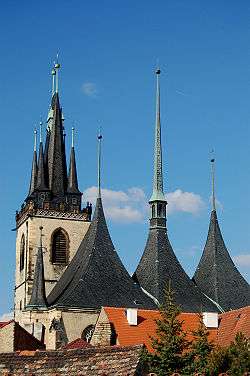Louny
| Louny | |||
| Town | |||
 | |||
|
|||
| Country | Czech Republic | ||
|---|---|---|---|
| Region | Ústí nad Labem | ||
| District | Louny | ||
| Commune | Louny | ||
| River | Ohře | ||
| Elevation | 185 m (607 ft) | ||
| Coordinates | CZ 50°21′26″N 13°47′49″E / 50.35722°N 13.79694°ECoordinates: CZ 50°21′26″N 13°47′49″E / 50.35722°N 13.79694°E | ||
| Area | 24.27 km2 (9.37 sq mi) | ||
| Population | 19,157 (2006-10-02) | ||
| Density | 789 / km2 (2,044 / sq mi) | ||
| Founded | 12th century | ||
| Mayor | Radovan Šabata | ||
| Timezone | CET (UTC+1) | ||
| - summer (DST) | CEST (UTC+2) | ||
| Postal code | 440 01 | ||
  Location in the Czech Republic
| |||
| Wikimedia Commons: Louny | |||
| Statistics: statnisprava.cz | |||
| Website: www.mulouny.cz | |||
Louny (Czech pronunciation: [ˈlou̯nɪ]; German: Laun) is a town in the Ústí nad Labem Region of the Czech Republic. It is situated on the River Ohře.
History
The first city foundation called Redintuinum took part in the 2nd century proved on Ptolemios`map.Part of the settlers moved westward and made way for Slaves. In the 12/13th century Germans resettled again. The city was founded in the 12th century (the first known written record dates from 1115). The Church of St Peter stands on the site of the original fort. The original name was Luna, which is retained in the name of a local park, Pramen Luna, and accounts for the Moon as part of the town's emblem.[1] The town developed and expanded during the reign of Ottokar I of Bohemia, although the Thirty Years' War depopulated the city. The second half of the 19th century witnessed the economic growth of the area.
Until 1918, LAUN - LOUNY was part of the Austrian monarchy (Austria side after the compromise of 1867), in the district of the same name, one of the 94 Bezirkshauptmannschaften in Bohemia.[2]
The town lies on a railway junction and a factory for overhauling railway engines and rolling stock was established in 1873[3] which became a major employer and contributed to the town's expansion during the early 20th century. The former state company has now been privatized, but remains the town's largest employer with a workforce of 750.
Other industries include a brewery (from the hops which are grown in the region) and a factory making porcelain electrical insulators for power cables, etc.
The town's architecture was formed mainly in the 19th and 20th centuries when many old buildings were torn down. Nevertheless, the most important architectural feature is Roman Catholic St. Nicholas Church, erected between 1517 and 1537 in the late Gothic style.[4] One of the architects was Benedikt Rejt. It incorporates a tower from an earlier church which was otherwise destroyed along with most of the town by a major fire in 1517.
Parts of the city ramparts remain, as does the Žatec gate which dates from 1500 but was reconstructed in 1872.
An Open-Air Museum of Archeology is located in nearby Březno.
Famous people
- Johann Aloys Schlosser, publisher and biographer, author of the first biography of Ludwig van Beethoven in 1827, (c. 1790-?).
- Kamil Hilbert, architect, (1869-1933).
- Václav Hlavatý, mathematician, (1894-1969). The Gymnázium V. Hlavatého (Secondary Grammar School) is named after him.[5]
- Karel Konrád, novelist, (1899-1871).
- Jaroslav Vrchlický, poet, (1853-1912).
- Zdeněk Sýkora, painter, (1920–2011).
_074.jpg)
- Kristýna Plíšková, tennis player
- Karolína Plíšková, tennis player
- Zdeněk Sýkora, abstract painter, Ordre des Arts et des Lettres award
- Kamil Linhart, painter
References
- ↑ Lounska farnost Description of the Church interior which has this emblem
- ↑ Die postalischen Abstempelungen auf den österreichischen Postwertzeichen-Ausgaben 1867, 1883 und 1890, Wilhelm KLEIN, 1967
- ↑ www.lostr.cz Company website
- ↑ History of the Church of St Nicolas and the Louny Parish
- ↑ Gymnázium V. Hlavatého
External links
- Official website (Czech)
- Louny Information centre (English)
- History of the Louny Parish (English)
| Wikimedia Commons has media related to Louny. |


